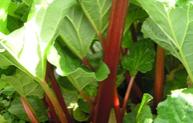Rhubarb

Growing Rhubarb
Varieties
German Wine, Macdonald, Crimson.
Propagation
Healthy, vigorous 3 to 4-year old crowns are divided to obtain two or more buds per seed-piece.
Soils
Use a well-drained but moisture-holding soil with a pH of 5.5 to 7.0. The lighter soils will produce an earlier crop but may require irrigation.
Fields to be planted should be plowed deeply and worked in the fall and spring to prevent the weeds from going to seed.
Fertilizers
A soil test is necessary to determine phosphate and potash requirements. Use the Vegetable Production Guide: Nutrient Management (PDF) for recommendations based on soil test results.
Lime should be applied if the pH is below 5.6. Do not apply manure or fertilizer within 2 weeks of the lime application.
Manure at 22 to 45 tonnes/ha (9 to 18 tonnes/acre) may be applied in the fall or as early as possible in the spring.
Fertilizer—In year of setting apply 80 kg/ha (32 kg/acre) nitrogen and the required phosphate and potash.
In subsequent years apply 170 kg/ha (68 kg/acre) nitrogen and the required phosphate and potash.
Fertilizer applications should be split into 3 side-dressings:
- Before growth starts in the spring
- After growth starts
- After harvest
Nitrogen rates may be reduced in the first two years with manure applications.
Planting
Planting is best done in the spring, but may be done in the fall where the soils are not likely to heave because of frost. The seed-pieces are planted 7.5 cm deep, 60 cm apart, in rows about 120 cm apart.
Row Covers
The use of plastic mini-tunnels applied over rhubarb in February will increase early yield, but will not affect total marketable yield. Growers may wish to apply covers (not slitted or perforated) over a few rows to establish an early fresh market.
See the “Plasticulture" section of the Vegetable Production Guide: Planting (PDF).
Harvesting
Stalks should not be pulled during the first year of growth. In subsequent years, harvesting can be expected to start toward the end of March and to end in June. This will vary with management practices, with the variety being grown, and with the market demand.
Plants should not be overpulled at any time, as a certain amount of foliage is required for the development of the present crop as well as next year’s crop.
A well-cared-for patch will last for 10 years or longer.
Rhubarb Weed Management
Pre-emergence
| Product | Rate | PHI* | Comments |
|---|---|---|---|
Sandea(halosulfuron) |
35 to 70 g/ha (14 to 28 g/acre) Apply in 140 L/ha (60 L/acre) |
60 |
|
Callisto 480SC(mesotrione) |
300 mL/ha (120 mL/acre) Apply in 100 to 200 L/ha (40 to 80 L/acre) water at 275 kPa |
42 |
|
*PHI = Pre-harvest interval
BUFFERS – Refer to product label for buffer requirements, and consult the Vegetable Production Guide: Pesticide Regulations and Safety (PDF).
PESTICIDE GROUP DETAILS – see the Vegetable Production Guide: Pesticide Toxicity Table (PDF).
Post-emergence
| Product | Rate | PHI* | Comments |
|---|---|---|---|
Venture L(fluazifop-P-butyl & S-isomer)Group 1 |
barnyard grass (2-5 leaf stage): 0.8 L/ha (0.32 L/acre) proso millet (2-5 leaf): 1.0 L/ha (0.4 L/acre) foxtails (2-4 leaf): 1.4 L/ha (0.56 L/acre) quackgrass (3-5 leaf): 2.0 L/ha (0.8 L/acre) |
14 |
|
Aim EC(carfentrazone-ethyl) Group 14 |
37 to 117 mL/ha (15 to 47 mL/acre) Apply in 100 L/ha (40 L/acre) of water |
1 |
|
*PHI = Pre-harvest interval
BUFFERS – Refer to product label for buffer requirements, and consult the Vegetable Production Guide: Pesticide Regulations and Safety (PDF).
PESTICIDE GROUP DETAILS – see the Vegetable Production Guide: Pesticide Toxicity Table (PDF).
Rhubarb Disease Management
Nematodes
Nematodes are microscopic worms which feed on plant roots and crowns. Infected plants are stunted with thin, narrow stalks. Plants seldom die but yields are greatly reduced.
Control
Before establishing new plantings, especially following berry crops or rhubarb, collect soil samples for nematode analysis. Fumigation may be required.
Ramularia Leaf and Stalk Spot
Conspicuous leaf spots appear early in the growing season. Under wet conditions, spots may appear on stalks reducing quality or making them unmarketable.
Control
Clean-up crop refuse at end of harvest by rotovating to encourage rapid breakdown.
Virus Disease
Rhubarb, being a perennial, vegetatively propagated-crop, is vulnerable to virus infection. Fortunately, plant to plant spread is usually quite slow in British Columbia.
Virus-infected plants are usually smaller than nearby healthy plants and the leaves often have distinct mosaic or ring patterns.
Control
In establishing a field, obtain healthy planting stock, or if doing your own propagation, select only the most vigorous- appearing mother plants. Rogue out and destroy plants with virus symptoms as they appear in a field.
